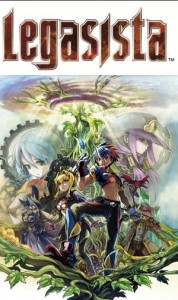Released on PSN in August, Legasista is the latest offering from Nippon Ichi Software in their survival action RPG series to be brought to a western audience. Published by NIS America, Legasista brings the gameplay found in the PSP based Cladun games to the PS3.
The game game opens with the protagonist, Alto, arriving at the Ivy Tower in search of a relic that will break the curse that turned his sister into a crystal. Alto is not alone though, as other characters are also searching the tower for relics. Voice acting is provided for all the story scenes, though sadly it is Japanese only.
The story provided in Legasista is not very deep, and seems to serve only to unlock additional features early on, but does eventually flesh out each character’s reason for being in the tower. Nor is it very long, as the story can be completed in less than twenty hours if the rest of the content is ignored. Some diving into dungeons will be required however, as after Ran-Geons (as the randomly generated dungeons are known) become available, enemies become harder fairly quickly.
Running through Ran-Geons is where the bulk of the gameplay comes from. As well as earning experience, loot is obtained more frequently, and could be of better quality, than that found in the story dungeons. Ran-Geons come in multiple difficulties, with the number of item drops and base monster level increasing with the difficulty. Harder dungeons also have fewer exits, which are important because items are lost when a character dies. Thankfully this does not include items brought into the dungeon, as much time and effort can be put into making decent equipment.
Equipment found in dungeons often has a ‘+X’ after its name, where ‘X’ is the number of titles and sub-titles that piece of gear has. Titles affect any associated sub-title, whereas sub-titles affect the gear itself. An example of this would be the title ‘Mana use +5’, which would increase the mana cost of associated sub-titles by five. The sub-title ‘ATK Up S’ which would normally cost three mana, now costs eight. Destroying a piece of gear will retain any sub-titles from the gear, which can then be used to overwrite existing sub-titles on another piece of equipment, allowing for rather powerful weapons and armor to be created.
Mana costs are what keep characters from quickly becoming overpowered. There are six character classes in the game, with each having access to multiple energy frames. Each frame is a unique way of allocating equipment slots to a given class, possibly with some drawbacks. Equipment slots limit the amount of mana that can be used to equip gear in that slot. Leveling up increases the amount of mana that can be spent in all gear slots, as well as increasing all HP bars and potentially some stats.
Levels gained only apply to the current job a character has. Leveling a job gives that character job points which can then be spent on abilities for any job that character has. Job abilities are the other way to improve characters. Most abilities give a flat bonus like ‘+5% to lead health bar’, and others are helpful while exploring dungeons. Job changes are available as long as characters are level twenty or above in their current job.
After a some of the story has been completed, players are able to send sentient bean sprouts out to explore. This can lead to the discovery of additional BGMs becoming available in the jukebox, or the availability dungeons that are otherwise unavailable. New beans sprout overtime and gain ability (a stat which determines their potential to explore) time goes on, though they can be lost while exploring or through lack of use.
The graphics in Legasista are sharp. It looks very much like NIS took Cladun and made an HD version of it. It is sad though, that many enemies look like they have been copied over from Cladun as well. All character models have some animation to them, as do character portraits during story scenes. The male characters look fantastic, although most of the female cast are either ridiculously top-heavy, or barely-clothed young girls.
The music in the game is a joy to listen to. The majority of tracks can be heard once the jukebox has been unlocked, with additional tracks being added as they are found through exploration. The jukebox lets the player select what music is played in the different areas of the game, meaning that the same dungeon tune can be swapped out for something else to encourage players not to mute the sound when exploring dungeons for hours on end.
In conclusion, Legasista excels on gameplay, while lacking story. It clocks in at roughly fifteen hours when doing the bare minimum, but keeps players hooked with Diablo-esque loot drops. People who enjoyed Cladun Should check this out, while keeping in mind that many enemies have been reused for this game.


